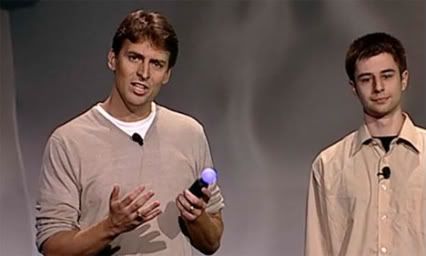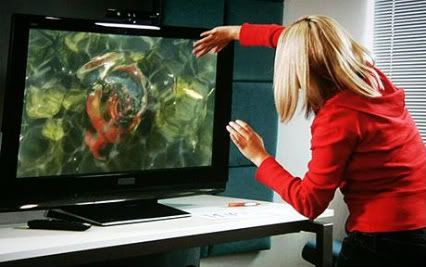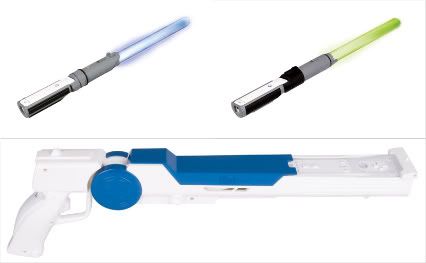The Art of Motion

As Sony and Microsoft scramble to release their motion controllers, it’s becoming clear that both are trying to build upon Nintendo’s original offering, take it further and expanding their respective customer bases.
I was recently discussing the whole Natal ‘revolution’ with someone who is associated with the technology’s history. He was trying to convince me how it will change the nature of the industry and become a ‘game changer’.
Sony too, are already in full PR mode explaining to the gaming press how their motion control will offer an unparalleled level of precision. Now I’m not going to tell you Natal or Sony’s won’t be as good as is being suggested, because I think they will be excellent. The technology behind them seems robust and its performance superb. We have seen video examples of people using them and they seem fast, responsive and accurate.

However, that alone doesn’t make them an industry changer. The idea that everyone is going to suddenly buy one is fanciful. Will it drive Xbox 360 sales? Perhaps, especially to some people who have not got a Wii. However the marketing will be complex, as they would need to rebrand the console to be able to move whole-heartedly into the casual space. Sony and Microsoft have both had casual games with alternative controllers out for some time, and neither have allowed them to cut into the mass market as Nintendo have been able to.
Just as the Wii suffers from not being perceived as a hardcore console (and that’s with more hardcore games being produced for it) so the 360 and PS3 suffer from being perceived as being hardcore and adult. Indeed, Scene It, Lips, Singstar and Buzz have so far failed to change this perception amongst the wider public.
Another issue of course is that not every existing or future PS3 or 360 user will actually buy the new controllers and that means developers still have to make games that won’t work with or take into account the new technology. It splits the platform, which can make it more expensive to develop for. Alternatively developers will add functionality in most games to support the controller, but it will rarely be key to gameplay, except for a few first party or key third party titles. If it’s not key to the gaming experience then many users will conclude that they can get along without it just fine. Sixaxis controller anyone?
I was chatting to an RTS fan the other day that was new to the whole console experience. He was taken aback at seeing Halo Wars on a big TV in my living room, but couldn’t understand why it didn’t have mouse and keyboard support. Clearly it can, but the developers know not all players will have one and then it creates two sets of players thereby making the gameplay experience harder to manage.

One of the other issues my friend, close to the ‘history of the Natal tech’, was trying to sell me on was that people don’t want to have to hold a device like a Wiimote. I had news for him. They do. That’s why there is a whole industry of bits of useless plastic which sticks onto your Wiimote. If you are playing tennis, you have a plastic tennis racket whilst golf benefits from a club or just the Wiimote in your hand. Now clearly Natal could be used with bits of plastic, but at that point you have then managed to undermine your USP for being controller free!
Sport games, shooting games, in fact lots of games all benefit from some tactile control over something physical in the real world. Additionally the Wiimote (along with the Motion Plus for argument’s sake) has buttons on it and an adapter with a traditional analogue stick. This means you can have motion and traditional gameplay at once. The guys at Nintendo knew what they were doing when they created the Wii. Sony’s device I believe has a button on it, but from what we have seen so far I’m yet to work out how players can have traditional character movement alongside ‘point and shoot’ dynamics. The latest preview was for the ‘upgraded’ version of Resident Evil 5 being produced for the new Sony technology. In the video we see a player holding one handed a traditional dualshock with the other handling the pointing. If proof is needed of why a ‘point and shoot’ device needs multiple buttons (and a comfortable nunchuk style analogue stick), then watching that video is it! I cannot imagine that being the preferred control scheme as it looks uncomfortable and tiring. Perhaps, nearer to release, Sony will announce a nunchuk style product; they certainly need to look into this.
Natal has no buttons, as it has no device to hold. However there is no reason why you can’t use a standard controller whilst moving your head or lobbing a grenade at the screen. Yet as most FPS games require you to be ‘hands on’ at all times (how many times have you thrown a grenade whilst strafing in Halo 3 or CoD?) it will be interesting to see how much extra interaction these traditional games can have with the motion technologies being offered. One area of real interest with Natal will be added viewing data via head movement – i.e. looking around corners.
There is of course one other major factor. Nintendo are hard at work with that massive R&D investment they are currently making. If we assume that they too are able to backwards engineer their Wiimote technology as countless other individuals have now done on YouTube, it would seem that the next step is for them to stick a camera on the sensor bar (which at present is just two led lights), resulting in camera based technology similar to Sony’s and Microsoft’s. If this can be used in addition to or with the current Wiimote tech (depending on the gameplay) then their experience will only become even more accurate and interactive. However it will be built on top of existing technology. Here, you see, is the killer point. If this new and improved Wii (whether it be HD or not) is 100% backwards compatible with the rather large existing Wii market, then it could be game over for Sony and Microsoft just as they start to catch up.

The Wii consumer is not accustomed to buying new consoles and new software every 2-3 years. This market owns multiple remotes, lots of games, a WiiBalance board and lots of plastic attachments. Are they all going to jump ship?
I’ll definitely have Natal, possibly also the Sony system. Fable 3 players will get Natal, as we assume it will use it. In theory these new controllers should continue the expansion of the gaming experience and also of the market in general. On the other hand, Microsoft and Sony might find that the launch of their new motion technologies becomes a distraction to their hardcore experience.
I would be surprised if it will be a game changer in this or the .5-generation that everyone is assuming we are moving into. Nintendo started this game with the Wii and will decide whether it’s a 2, 3 or 5 set match.
Related posts:





Good points throughout, but I can’t share your enthusiasim for Natal or Sony’s ‘new’ idea. I find some of my Wii games just too much like hard work, which is one reason it hardly gets used! I avoid the sixaxis wherever possible, and can’t imagine having to shift about in my game chair just to peek around corners! I like to get into ‘the zone’ where my fingers do the talking and my body dissapears. I’m not disputing the possibility of these systems taking off, Joe Soap buys into anything now-a-days (I’m looking at you, PSP Go!)
And before you ask, I only weigh 12 stone!
I know what you mean KrazyFace, sometimes it’s good to like sink deep into your chair, let your muscles atrophy and just chill out and play a game. But Wii’s sold exceptionally well to the more ‘casual’ gamer and they’re promoted as good for children in that they keep them active at the same time as playing games.
It’s kind of a logical step for Sony and Microsoft to take a step into that market, because right now Nintendo has a 100% share in it. Even if quite a few PS3 and 360 owners don’t adopt the new technology, they’re making their systems more viable in the family market.
But I don’t believe motion control is the way forward in gaming as a whole, because for a lot of gamers it’s about relaxation and being engrossed into a story or world, in perhaps the same way as a film. When I want to excercise and play sport, generally thats what I do, when I want to sit back and play a game – thats what consoles or a PC is for.
“But I don’t believe motion control is the way forward in gaming as a whole, because for a lot of gamers it’s about relaxation and being engrossed into a story or world, in perhaps the same way as a film. When I want to excercise and play sport, generally thats what I do, when I want to sit back and play a game – thats what consoles or a PC is for.”
I think this is spot on. The main problem with motion controls is that without physical feedback they are never that immersive. I don’t feel more “in” the game because I’m flailing my arms than I would have if I was just pressing buttons in the same pattern. I can’t muster up any genuine excitement over either the Wand or Natal for this reason.
Having said that, it’s a very well-written and thoughtful article and you make many good points.